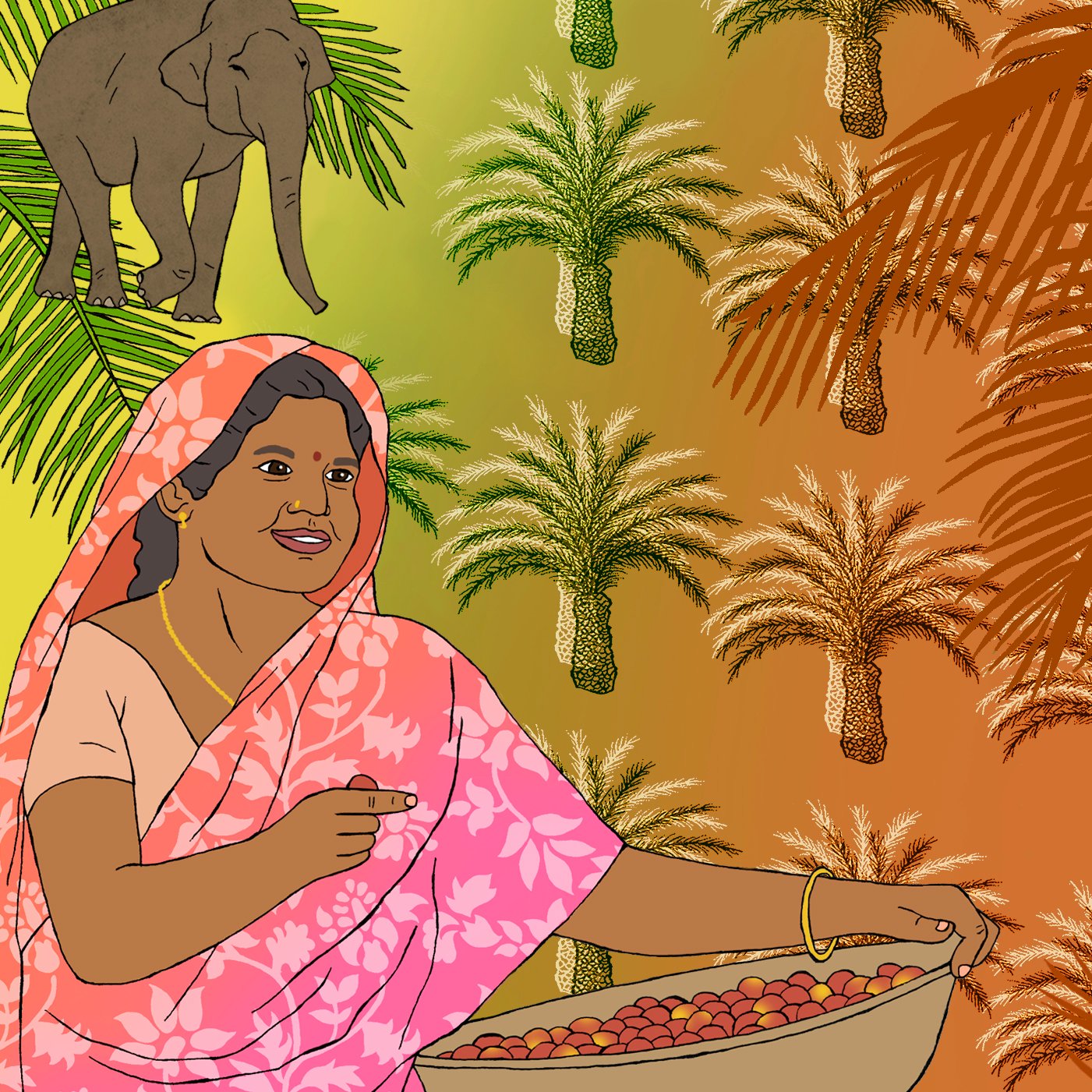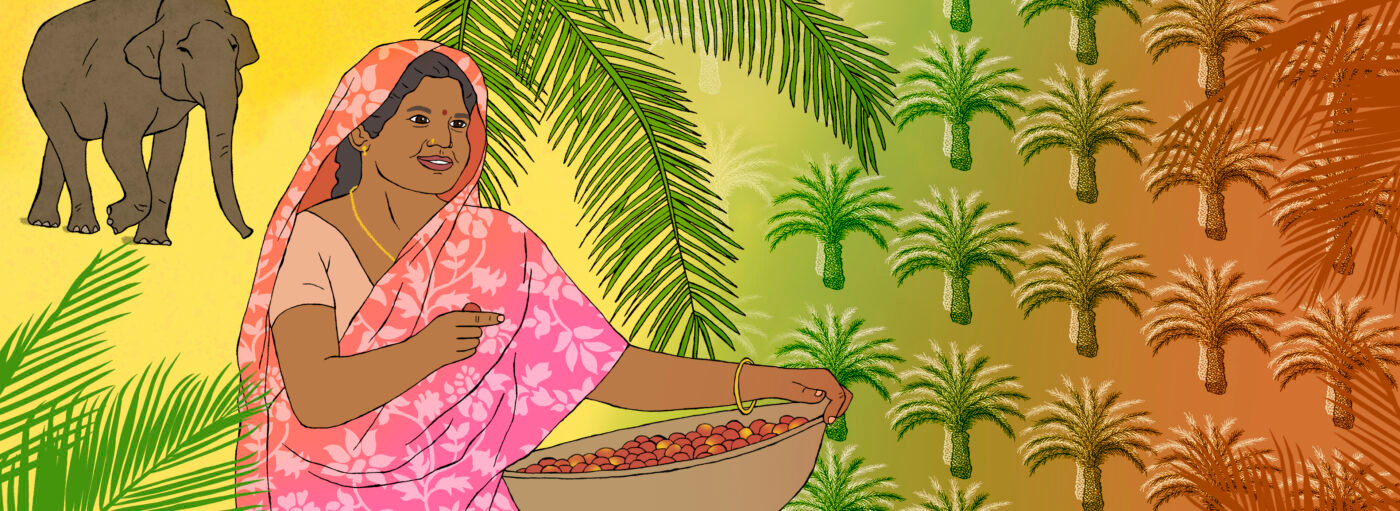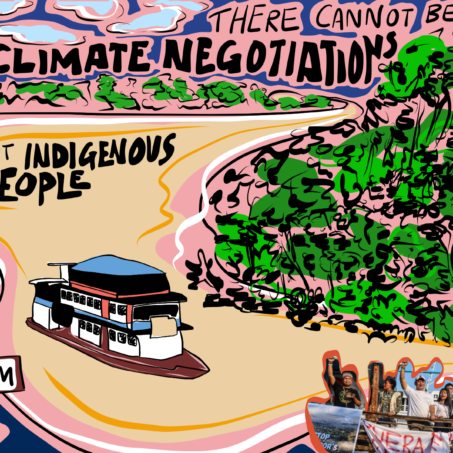The Northeastern Region of India is separated from the rest of the mainland by a thin stretch of land called the Siliguri Corridor. At its narrowest, it’s only 20 kilometres wide, sitting above Bangladesh and below Nepal – a relic of the brutal way that land was divided during Partition in 1947.
Today, a significant proportion of the agricultural industry in the region is dedicated to rice crops and other cereals, as well as its infamous Assam tea.
More recently, palm oil cultivation has ballooned in the region, with the Assamese government planning to encourage palm oil plantations in 17 districts in the state. Not only is palm oil production more profitable than growing rice, but it’s also been touted as a solution to growing unemployment in a number of states, including the northeastern states.
For instance, Tripura, one of the states in the region, has an unemployment rate of 25%, according to statistics from the Ministry of Development of the North Eastern Region.
That is why there is huge government support, both state and country-wide, to plant and cultivate palm oil – the national government has even launched dedicated initiatives to financially encourage and incentivise farmers.
Through these programmes, oil palm crops are offered as alternatives to low-yield crops, with the view that cultivating palm oil will be more profitable for farmers themselves.
In addition, given that India is the world’s largest importer of palm oil at present, growing a domestic industry is hoped to help the country reduce its reliance on others. That is part of Prime Minister Narendra Modi’s strategic vision to build self-reliance within the country – and in the long run, make it an attractive business landscape for foreign investment as well.
In March 2023, the Indian government considered increasing the import tax on palm oil, which would not only boost domestic cultivation, but also increase support for farmers cultivating rapeseed and sunflower oils.
Where does that leave farmers and traditional farming methods?
This isn’t a new problem: the Department of Agriculture in Mizoram, another one of the states in the region, began financially incentivising palm oil cultivation as far back as 2006, providing farmers with “free saplings and water tanks.”
The goal was to alleviate poverty and enhance food security, but some of the main organisations contributing to this initiative were agro-industrial companies and multinationals. Farmers were encouraged to loan cultivation equipment from banks, and yet the extent to which farmers themselves were consulted through this process is still unclear.
It’s now been revealed, over 15 years later, that this ongoing palm oil cultivation has proven to be hugely damaging for the region’s animal life. One impact has been the increase in human-elephant conflict, as land has been cleared to expand palm oil cultivation. This has led not only to other crop fields being destroyed, but also to human deaths.
Governments have been, and are, offering plenty of financial incentives to support farmers transitioning to palm oil cultivation. This, it seems, has little regard for subsistence and small-scale farmers, and those who grow multiple, diversified crops. A huge amount of land is also required to cultivate and sell palm oil at the scale that the Indian government envisions. For instance, the southern state of Telangana is planning a 22-fold expansion to the land used for palm oil cultivation.
In this context, with external, institutional pressure, preserving and promoting Indigenous farming methods is both a political act, and one of survival.
For the North East Slow Food and Agrobiodiversity Society (NESFAS), bringing together small-scale farmers from across the region not only facilitates knowledge-sharing, but is also critical to the long-term food sovereignty of villages and communities at a more grassroots level – despite the legislative and regulatory frameworks being passed much higher up the chain.
”Homogenisation of agriculture globally has helped us to meet immediate targets and goals, but there are a lot of trade-offs,” says Dr Dhrupad Choudhury, whose research and consultancy is focused on climate change and training. When we look at environmental sustainability as a currency, he adds: “monocultural farming has been a very expensive practice for nature.”
In other words, while this style of farming has been upheld by many as the way to meet global demand for food, the effect that it has had on the land essentially renders that land unusable in the long-run. A combination of pesticide use and a lack of resilience in crops themselves threatens food supply at both local and global levels.
Dr Choudhury has been working with rural communities in the Himalayas for over two decades, focusing on helping communities adapt to the changing climate and other pressures. The goal of his work is to ensure adaptation occurs in tandem with secure local economies and livelihoods.
The push for palm oil cultivation in the region comes in stark contrast to guidelines released by state governments that encourage natural farming, adds Bhogtoram Mawroh, a senior associate focused on research and knowledge management.
But it’s clear from the guidelines that those setting them don’t know about how natural farmers actually work. “People in our region don’t always cultivate in one area. Rather, they move around a lot,” says Bhogtoram. “Our people have been left out of the guidelines.” This signals a wider problem: whether or not farmers are consulted extensively enough when building these guidelines, or whether they are being produced to meet arbitrary sustainability goals. Either way, achieving environmental sustainability through natural farming, while putting the economic sustainability of smallholder farmers at risk, seems like a half-baked strategy.
For Dr Choudhury, this is an institutional and legislative failure: “the right hand doesn’t know what the left hand is doing.”

Join our mailing list
Sign up for shado's picks of the week! Dropping in your inbox every Friday, we share news from inside shado + out, plus job listings, event recommendations and actions ✊
Sign up for shado's picks of the week! Dropping in your inbox every Friday, we share news from inside shado + out, plus job listings, event recommendations and actions ✊
How is NESFAS keeping the science of Indigenous agriculture alive?
With these confusing guidelines emerging in the backdrop, reviving, defending and promoting Indigenous food systems is a form of political and cultural resistance.
Preserving Indigenous ways of cultivating the land allows local people – who have been taking care of the land themselves, without external intervention – to make decisions in an autonomous way. It allows them to make decisions that prioritise their land and food sovereignty at a local level, rather than succumbing to economic pressures.
As Robin Wall Kimmerer, and various other Indigenous scholars have pointed out, in a dominant culture that often puts Western (read: capitalist) schools of knowledge on a pedestal, centering Indigenous knowledge, which has been cultivated and added to for hundreds — if not thousands — of years, is a radical act. In the context of farming and agriculture, that also means respecting the knowledge that the natural world and plants have, and understanding how they grow in conditions that help them thrive.
It’s also a feminist act, the NESFAS team adds, because women are the ones primarily involved in farming. Statistics gathered in the state of Meghalaya suggest that nearly 70% of women rely on agriculture as their primary source of income, but over 90% don’t own land themselves. They also lack access to credit, new agricultural technologies, and relevant skills and education, the study found.
Empowering women to preserve and share their own farming methods, which have been passed down through generations, means that they don’t fall victim to external pressure to expand their farms into new crops that they might not know enough about.
It also means that they’re able to continue earning an income through the skills they already have and have honed, rather than having to retrain or upskill in a field outside of agriculture. As a result, they’re able to stay local to their families, while many have to move to urban areas or major cities for a source of income, then sending money home to their families.
“Farming reflects a community’s identity, culture, value systems and also how you connect to nature,” Dr Choudhury adds. “Are you harmonious with it, or is it a resource that you want to exploit for your own good?”
This deep relationship to local ecology allows the community to efficiently manage its resources, which includes sharing anything that is produced or cultivated in excess, rather than letting it go to waste.
It also inspires more long-term thinking, which is why intergenerational learning and knowledge transfer is a primary pillar of the work that NESFAS do with the farmers in their community. “It’s about looking at crops not just as a production system, but seeing what else farming can unlock,”, Dr Choudhury explains.
How are farmers in northeastern India adapting to the climate crisis already?
However, not only are Indigenous practices under threat from irresponsible farming guidelines that favour yield over land health and sustainability, but the crops themselves are increasingly at risk from a changing climate.
“Meghalaya broke a heavy rainfall record [recently], where many of the potato crops were either destroyed or spoilt,” Bhogtoram tells me. And even the crop varieties that are highly resilient to climate stressors — such as wild vegetables — aren’t always high-yield, which puts farmers under economic strain too.
This has compelled farmers to come up with innovative ways of working around these climate-induced emergencies, explains Gratia Dhkar, a lead associate focused on agroecology and training. And while this is ingenious and smart, it’s important to keep in mind that farmers in this region shouldn’t have to be taking such measures to keep their farms afloat. The fact that they have to continue to find innovative ways to increase resilience is a direct result of exclusionary national policies, and the globally climate crisis which disproportionately affects people in the Global South.
“Our people have a way of building resilience. Potato crops have been destroyed, but they’ve still kept a corpus of seeds for such instances,” she says. Different communities are also coming together increasingly to share information about unfamiliar crops, supplementing gaps in one another’s knowledge as a means of bringing everybody up together.
This knowledge-sharing is also a critical part of the puzzle when it comes to preserving Indigenous farming methods and collectively working against the tide of pressure from state governments. It champions age-old agricultural knowledge that has been passed down and adapted for the climate and land quality, rather than favouring a knowledge system that is centred around economic benefit.
“The farmers are scientists in their field, but they don’t have the luxury of failing,” Gratia adds. She gives an example of one farmer that saw increased instances of pests on her crops, and who decided to change the month that she’d sew her seeds in, in order to assess whether that alleviated the pest issue. “These experiments and learnings from the field are important to adaptation and mitigation of climate change,” she explains.
While the concept of ‘climate change’ doesn’t always translate into South Asian languages in a succinct way, what is clear is that farmers are noticing the variability in weather, seasonal changes, periods of dryness, and intensity of rainfall – and taking logical action to mitigate the effects of these changes.
“Due to heavy rainfall that was later in the year, high-yielding varieties brought in by the agriculture department fell over, as they had long stalks. The local people replaced them with a dwarf variety,” says Dr Choudhury. That, he adds, led to fewer crops being destroyed in the rain.
Keeping a diverse range of crops – perhaps the antithesis to what the state governments are suggesting in the region – is a “risk aversion mechanism,” he says. “You could put your salary in one place, or you could spread it out, to mitigate any losses. It’s the same rationale for crop diversification.”
A whopping 85% of farmers in India cultivate crops on small plots of land — under two hectares or five acres. In light of ongoing draconian legislation that threatens their livelihoods and economic stability, farmers are increasingly also dying by suicide: in 2021, over 5500 suicides were reported, an increase of 29% in comparison to 2019, according to the National Crime Records Bureau.
Amid these circumstances, policymakers in India are focusing on building India up as a place for business, rather than making it liveable for its own people. In focusing efforts on making India a key exporter of certain crops, it is exposing thousand-year old lands to the threats of monoculture farming and pesticides. In attempting to grow a middle class, it’s strangling anybody who doesn’t and cannot ever qualify.
What can you do?
- Read about how NESFAS is raising awareness of, and celebrating the importance of, traditional millet crops in the northeastern region of India, emphasising the crop’s resilience.
- Check out this joint investigation by Mongabay, the Gecko Project and BBC News, which breaks down the lack of reliable data on the palm oil industry in Indonesia, and ongoing disputes between palm oil corporations and smallholder farmers.
- Watch this short documentary on palm oil cultivation in Kerala, in southern India, and the country’s reliance on the product.
- Read more articles from our Land Defenders series HERE

The small agriculture environment transitions into a palm tree plantation which is rapidly spreading.”




